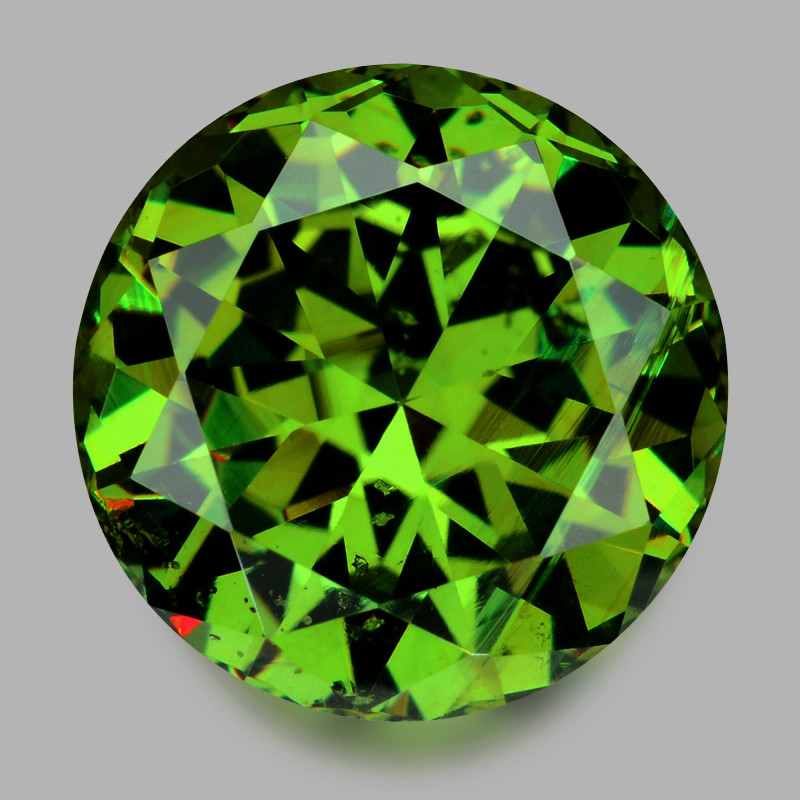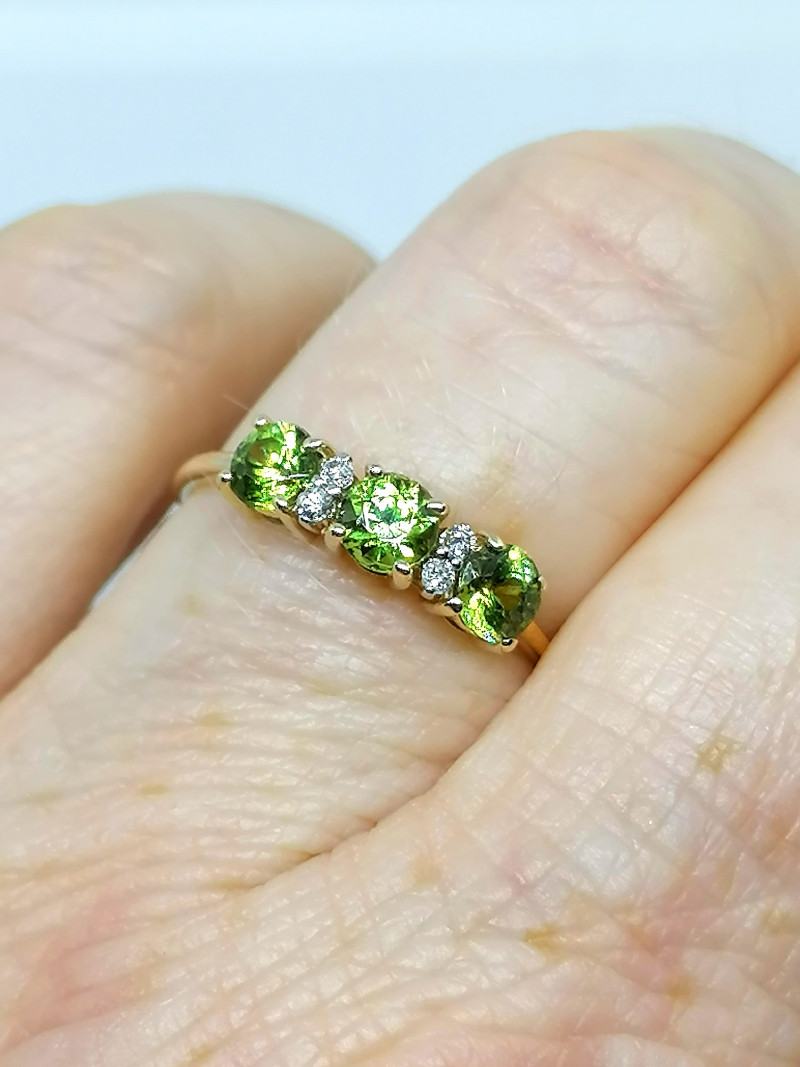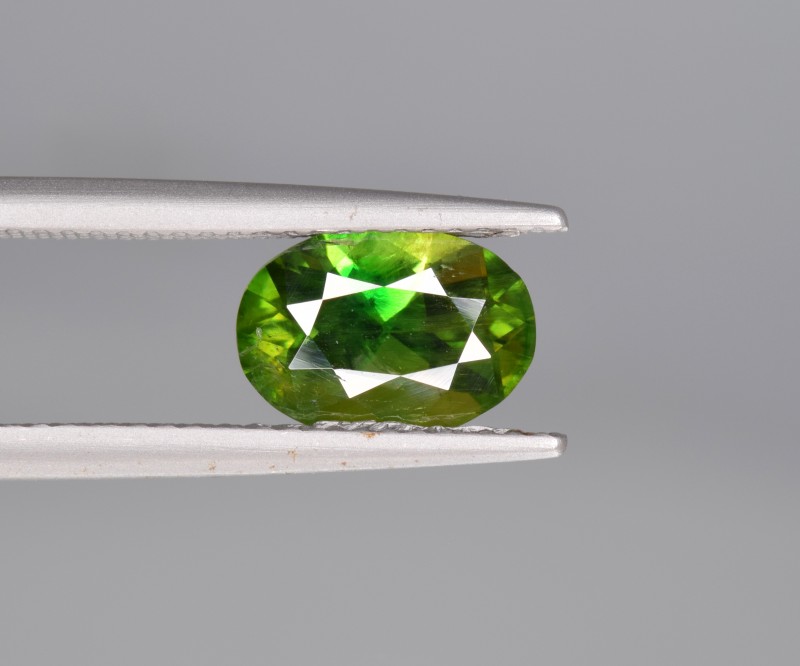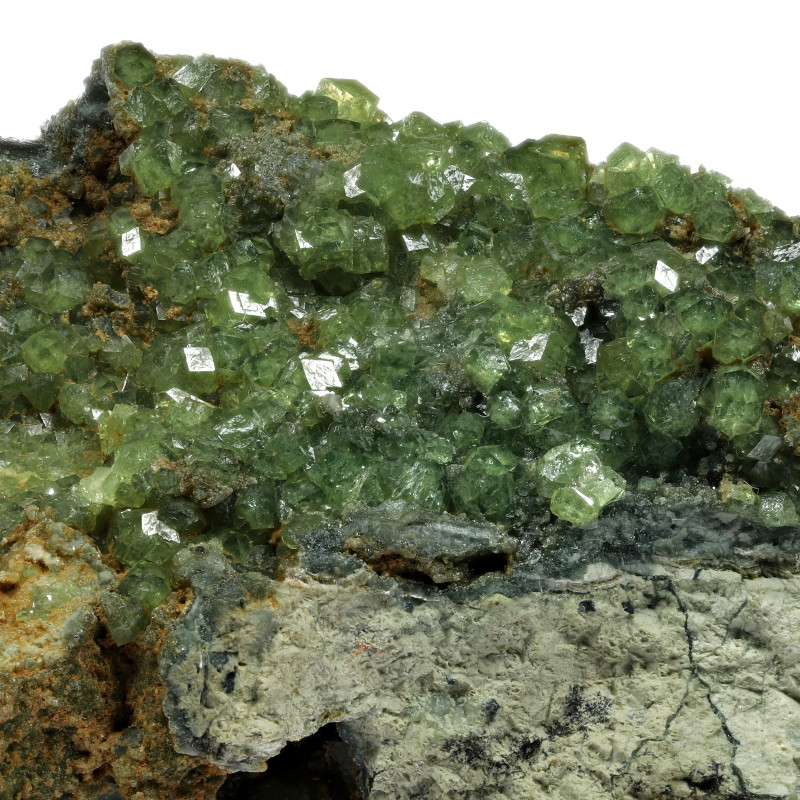Demantoid Garnet: Properties, Meanings, Value & More
 Demantoid is a garnet gemstone variety with an emerald-green color and mesmerizing, diamond-like sparkle. This type of garnet originates from Russia, sometimes dubbed the “Czar of garnets.” It’s known for being the most brilliant and currently most valuable garnet variety.
Demantoid is a garnet gemstone variety with an emerald-green color and mesmerizing, diamond-like sparkle. This type of garnet originates from Russia, sometimes dubbed the “Czar of garnets.” It’s known for being the most brilliant and currently most valuable garnet variety.
Are demantoids rare? Very rare — one of the rarest varieties of garnet, in fact! You probably know red garnets the best, as green is one of the rarest but also very desirable garnet colors. Even further, demantoid is one of the rarest colored gemstones, too!
Want to know more about this gorgeous rarity? This guide will teach you everything about demantoid garnet properties, history, prices, and more!

About Demantoid Garnet
Demantoid is a brilliant green semi-precious gemstone in the andradite garnet species. The only other green garnets are uvarovite, tsavorite, sometimes Mali garnet, and of course, demantoid.
Because it resembles peridot, other names used for demantoid include olivine, Uralian emerald, Ural chrysolite, Siberian chrysolite, and Bobrovsk emerald. However, these are all incorrect and against regulations set by the Federal Trade Commission (FTC).
As a garnet, demantoid serves as a birthstone for January, as well as a Capricorn or Aquarius zodiac stone. Additionally, green garnets traditionally commemorate the 25th wedding anniversary!
Demantoid Specifications & Characteristics
Demantoid is an andradite, the iron- and calcium-rich garnet species — formula Ca3Fe2(SiO4)3 — in the larger ugrandite garnet group. Other andradite garnets are topazolite, melanite, and rainbow andradite, but demantoid is the most valuable and widely known andradite variety.
The easiest way to identify demantoids is by the presence of horsetail inclusions (discussed more in-depth in the Clarity section). Not every demantoid has these inclusions, but demantoid is the only green gemstone that has them. Outside of demantoid, they’ve only been found in brown andradite as of 2018.
With a Mohs scale ranking of 6.5 to 7, demantoid’s hardness is the only trait that puts it slightly below other garnets.
On the other hand, demantoid beats other garnets with its diamond-like luster and high dispersion (a.k.a. “fire” or colorful sparkle). The dispersion (0.057) is even higher than that of diamond at 0.044!
Here are all of the demantoid garnet properties:
Mineral family: Andradite Garnet
Mohs hardness: 6.5-7
Color: Yellow-green, emerald-green, or deep green, sometimes brownish tint
Crystal structure: Isometric/Cubic
Luster: Adamantine
Transparency: Transparent
Refractive index: 1.880-1.888
Density: 3.81-3.89
Cleavage: None
Fracture: Conchoidal
Streak: White
Luminescence: None
Optical effects: Rarely chatoyancy
If you know green garnets, you may wonder: is demantoid the same as tsavorite? Not exactly.
 Pictured: Tsavorite
Pictured: Tsavorite
Demantoid vs. Tsavorite
Demantoid and tsavorite are the best-known green garnets, but also the rarest and priciest. However, they are distinct varieties.
Here are the differences, with values given as [demantoid] vs. [tsavorite]:
Species: Andradite vs. grossular (or grossularite).
Cause of Color: Chromium vs. chromium & vanadium.
Toughness (Tenacity): Poor vs. good.
Density: 3.81-3.89 vs. 3.34-3.73
Hardness: 6.5-7 vs. 7-7.5
Refractive Index: 1.88 vs. 1.74
Clarity: Type II (moderate inclusions) vs. Type I (few to no visible inclusions)
Additionally, demantoid can have inclusions that increase its value (horsetail), but tsavorite’s inclusions always decrease its value. Plus, both stones are rare in large sizes, but tsavorite gems come in larger sizes than demantoid gems.

Demantoid Meaning & History
Symbolically, the demantoid garnet meaning ties to light, courage, and adventure. As a garnet, it also represents prosperity, commitment, and friendship.
In Christianity, garnets are sometimes seen as holy talismans symbolizing faith and truth. Islamic beliefs reference palaces or levels of heaven made of garnets. Throughout the Middle Ages, various peoples wore garnets for protection, from soldiers to everyday folks.
The name “demantoid” comes from the term demant or diamant, meaning “diamond” after the garnet’s luster and sparkle that resemble (or exceed) that of diamond. Sources vary on the word’s origin, citing Dutch, German, or French.

History
The first discovery of demantoids occurred near the Ural Mountains around 1853. Local children found the grassy-green stones in the Bobrovka River runoff, but Russian mineralogists believed the stones were peridot.
In 1854, the Finnish mineralogist Nils von Nordenskiöld studied these Russian gemstones on a trip to the area and recognized them as a unique mineral. After a decade, Nordenskiöld shared his research with the St. Petersburg Mineralogical Society, naming the stone demantoid, or “green diamonds.”
While higher-ups accepted the name, publishing it in 1878, locals still called the stone “Ural chrysolite” because “demantoid” sounded like a rude word in their dialect.
Ups and Downs of Demantoid Popularity
From the 1870s to 1918, demantoid’s popularity in Russia soared, adorning nobility and appearing in prestigious collections such as those of Peter Carl Fabergé. Exports of demantoids to Europe helped popularize the gem in Art Nouveau jewelry of the Belle Époque era. It even became a favorite of English King Edward VII.
The booming popularity meant Russian mines were depleting fast. However, renowned Tiffany & Co. gemologist George Kunz bought up much of the Russian supply in the late 1800s, just before mining stopped in 1917.
The 1917 Bolshevik Revolution in Russia made demand for “elite” items like demantoid cease, with the Communist era favoring utilitarian materials over jewelry.
In the 1980s and ‘90s, miners discovered more Russian demantoid deposits. Namibia revealed a new deposit, nicknamed the “Green Dragon” mine, in 1996. Mostly recently, an important demantoid locale was discovered in Madagascar in 2009.

Demantoid Healing Properties
Like all garnets, or gemstones for that matter, demantoids can be potent healing stones. These gems can bring the emotional balance and soothing properties inherent to all green gemstones.
Additionally, demantoid is a heart chakra stone, opening this energy center to infuse your spirit with self-love and resilience in the face of change.
Let’s look at how the demantoid crystal aids your physical and emotional wellbeing.
Physical Healing
Crystal healers recommend demantoid to help with:
Nightmares
Liver, lung, and heart diseases
Hemorrhages
Breathing problems
Emotional Healing
After 2020, feelings of loneliness are essentially commonplace. Luckily, demantoid is said to help resolve these feelings, helping you become comfortable with yourself and feel connected to others, even from afar.
Other purported benefits include reducing stress while increasing bravery. Couples may benefit from demantoid, as it’s said to help resolve conflicts in relationships and promote positivity.
Besides spiritual use, is demantoid garnet valuable? It depends on its value factors, or gemstone properties.

Demantoid Gemstone Properties
With colorful fire, no cleavage, and beautiful luster, demantoids make great jewelry gems. An individual demantoid’s value comes from where it falls on color, clarity, cut, and carat weight, along with if it's been treated.
Color
Demantoid’s green hue can be yellow-green, golden-green, grass-green, or deep green. The green coloration comes from chromium impurities. Yellow overtones (which are common) and brownish tints are both caused by ferric iron impurities.
Iron impurities are higher and more common in Namibian demantoids, which lean toward olive, brownish-green, or yellow-green.
Higher saturation usually means higher value, but it can also lower the visible dispersion (colorful sparkle) that makes demantoid so special. Paler yellow-green stones display the best dispersion, making them valuable as well.
Interestingly, German and Russian gem dealers favor the yellow-green demantoids with high dispersion, while American gem dealers seek out the deeper-colored demantoids.
Clarity
Demantoid has a Type II colored gemstone clarity grade, meaning it usually has some visible inclusions. Common inclusions or blemishes (surface-level) that lower demantoid’s value are stress fractures in Namibian stones or surface abrasions.
Adding to its rarity, demantoid is among the few gems with a value-increasing inclusion: horsetails.
Horsetail inclusions are wispy, thin fibers of chrysotile (a serpentine variety) that radiate outward from a tiny chromite crystal inside the demantoid. The golden fibers’ shape resembles a horse’s tail in the wind.
Most horsetail-included demantoids come from Russia, though not all do. Russian demantoid already carries the highest value, making those with horsetail inclusions even more valuable.
Horsetail-included demantoids must be cut a certain way to best display the inclusions.
Cut
If a demantoid has horsetail inclusions, the lapidarist (gem cutter) must position the stone so the inclusions point upwards toward the crown.
Demantoids are almost always faceted, often in cushion, oval, and round shapes. However, lapidarists often let the demantoid’s raw shape determine the faceted shape, as preserving material (not wasting rough) is top-priority.
Some demantoids with a rare “cat’s eye” effect (chatoyancy) or less desirable coloring become cabochons.
Carat Weight
Most demantoids, rough or faceted, are small. Faceted gems over 1 ct are rare though not unheard of. Similarly, demantoid rough is typically 1-3 cts. Faceted demantoids from sources besides Russia or Namibia are rarely larger than 0.25 cts.
The price-per-carat rate increases for demantoid gems over 1 ct. Currently, the largest faceted demantoid is over 21 cts and the largest demantoid stone is 252.5 cts.
Treatments
Sometimes, jewelers heat demantoid to enhance its color. The treatment doesn’t affect the stone’s stability. Treatments will slightly lower value.

Demantoid Formation & Sources
Andradite garnets like demantoid usually form in metamorphic environments. Most geologists believe andradites form in certain limestones (those with more calcite than dolomite and replacement of some calcite with silica).
The formation happens when these limestones transform through either contact metamorphism (due to heat from magma) or regional metamorphism (due to heat and pressure).
Demantoids can appear in almost any rock, but usually show up in limestones, pegmatites, skarns, or ultramafic rocks like peridotite.
Once it forms, where do you find demantoid garnet?
Mining Locations
The most significant demantoid sources are Russia and Namibia. Russian demantoid is the industry-standard for quality, and Namibian demantoids are more yellow, thus considered lower-quality than Russian ones. One exception is the recently discovered, rare color-changing (yellow to green) Namibian demantoids.
Other demantoid sources are:
Afghanistan
Azerbaijan
Canada
DR of Congo
Italy (deep apple-green)
Iran
Madagascar
Mexico
Pakistan
South Korea
Sri Lanka
USA (California)
Because of the widespread association between demantoid quality and certain locales, the source can significantly impact demantoid’s price. Most notably, a Russian origin can mean exponentially higher value.
Speaking of price…

Demantoid Price & Value
Every gemstone property influences the demantoid garnet price per carat. For instance, faceted gems under 1 ct range from $300-$1,200 per carat, while stones weighing 1-3 cts range from $300-$1,500 per carat.
The specific price between the ranges can come from color saturation, dispersion, clarity, and treatments. The highest-quality stones can exceed $10,000 per carat, particularly high-quality Russian demantoids with horsetail inclusions.
Generally, well-colored stones with moderate clarity are around $500 per carat. Demantoids in larger sizes with good coloring and good clarity are $2,000 to $7,000.
Slightly less expensive options are Namibian demantoids with yellower coloring. While Russian demantoid gems usually start at $1,000 per carat, Namibian demantoids at wholesale start around $20 per carat.
Rough demantoid varies considerably, starting around $2 per carat and reaching $180 per carat at wholesale.
With those prices, proper gemstone care is crucial!
Demantoid Care and Maintenance
Because of its low hardness, a vulnerable demantoid ring should have protective settings. Other jewelry options are safer.
Clean demantoid with a soft toothbrush dipped in warm water and mild soap. Dry it with a soft, non-abrasive cloth. Store the gem separately from other stones.

Shine Like Royalty in Demantoid!
We may not see this gem adorn royalty the way folks did in the 19th century, but that doesn’t mean you can’t feel like nobility in demantoid jewelry.
More importantly, wearing or carrying a demantoid stone allows your inner light to shine as brightly as the gem itself!
Was this article helpful?
6 people found this article helpfulRoss Sedawie
- Written - 29th Jan 2015
- Edited - 30th Oct 2023

















